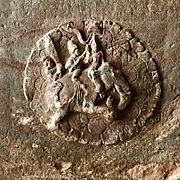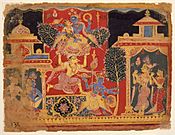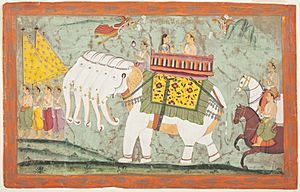Indrani facts for kids
Quick facts for kids Indrani |
|
|---|---|
| Queen of the Devas Goddess of Marriage and Beauty |
|
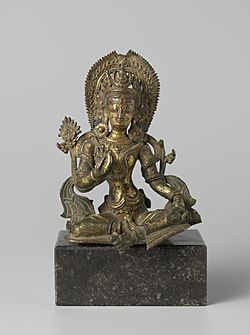
c. 1500–1600 Indrani from Nepal, depicted as consort of Indra
|
|
| Other names | Shachi, Poulomi, Aindri |
| Affiliation | Devi, Matrika, Shakti, Adi-Shakti, Durga |
| Abode | Amaravati, Indraloka, Swarga |
| Mantra | ॐ ऐन्द्री नम: |
| Weapon | Vajra, Astras ,Trisul |
| Day | Sunday |
| Mount | Airavata |
| Gender | Female |
| Festivals | Navratri |
| Personal information | |
| Consort | Indra |
| Children | Jayanta, Rishabha, Midhusha, Jayanti, Devasena (Shashthi) |
| Parents | Puloman (father) |
Indrani (also known as Shachi) is a powerful goddess in Hinduism. She is the queen of the devas, who are gods. People describe her as very beautiful, strong, and kind. She is also linked to the planet Venus.
Indrani is the daughter of an asura (a type of powerful being) named Puloman. She is married to Indra, who is the King of the Gods.
She is an important goddess in Shaktism, a major part of Hinduism that focuses on goddesses. Indrani is one of the Sapta Matrikas, which means 'seven divine mothers'. In South India, people sometimes worship her as a main goddess. Across India, she is often worshipped alongside Indra. Indrani is also mentioned in the texts of Jainism and Buddhism.
According to old stories, many wanted to marry Indrani because of her amazing beauty. Once, Indra was away doing penance (a spiritual practice). A human king named Nahusha became the temporary ruler of heaven. He tried to force Shachi to be his queen. But she was very clever and tricked him. This plan helped her get rid of Nahusha and reunite with her husband.
Contents
Understanding Indrani's Names
Indrani has several names, each with a special meaning. Her main name, Indrani, simply means 'queen of Indra'. This is common for goddesses in ancient texts. Interestingly, Indra is also known by his wife's name. He is often called Shachipati, meaning 'husband of Shachi'.
What Does Shachi Mean?
Her other important name is Shachi. This name can mean 'speech' or 'power of speech'. It comes from a Sanskrit word that means 'to speak'. Shachi is also linked to a word meaning 'power' or 'strength'. Some experts believe the name Shachi hints at the idea of Shakti, which is the personification of divine power. Other people translate Shachi as 'divine grace'.
Other Names for Indrani
- Aindri – 'wife of Indra'
- Poulomi – 'daughter of Puloman'
- Devarani – 'queen of devas'
- Charudhara – 'beautiful'
- Shakrani – 'wife of Shakra' (Shakra is another name for Indra)
Indrani in Ancient Stories
Early Vedic Texts
Indrani first appears in the Rigveda, a very old Hindu text from around 2000 BCE. Unlike some gods who represent nature, Indrani's story doesn't explain her existence through nature. She likely started as Indra's wife.
She is mentioned many times in the Rigveda. One hymn says she is the luckiest woman because her husband, Indra, cannot die of old age. While she is mentioned more than other goddesses who are wives, her husband often overshadows her.
One hymn praises her beauty and mentions her jealousy of rivals. Another hymn describes Indrani as boastful. She claims she has control over her husband. Even so, she asks the gods to help her get rid of any rivals for Indra's affection.
Later texts, like the Shatapatha Brahmana, call Indrani Indra's beloved. The Taittiriya Brahmana suggests Indra chose Indrani over other goddesses because of her beauty.
Epic and Puranic Stories
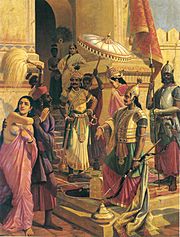
In later Hindu texts, like the epics Ramayana and Mahabharata, Indrani is more often called Shachi. She is known as the daughter of Puloman, an asura. She married Indra and became the queen of the gods.
The Bhagavata Purana says Indra and Shachi had three sons: Jayanta, Rishabha, and Midhusha. Some texts also mention a daughter named Jayanti. Jayanti married Shukra, who was Indra's rival. In some stories, Indra and Shachi gave their daughter Devasena to Kartikeya.
Shachi is not always a main character in these stories. This might show that Indra's importance changed over time. Her most important role is in the story of Nahusha.
The Story of Nahusha
According to the Mahabharata, Indra once killed a demon named Vritra. This act was a serious sin, so Indra went into hiding to do penance. During this time, the gods chose Nahusha, a powerful human king, to rule heaven.
Nahusha soon became proud and wanted Shachi to be his queen. Shachi refused his advances and sought help from Brihaspati, Indra's teacher. The gods told her to bring Indra back. Shachi came up with a plan and went to Nahusha. She told him she would only accept him if he waited until Indra was found. Nahusha agreed.
Indra was found and forgiven for his sin. But he refused to return because Nahusha was king. He went back into hiding. With the help of the goddess Upashruti, Shachi found Indra in Lake Manasarovar. Indra suggested that Shachi trick Nahusha to remove him from power.
Shachi returned to Nahusha and asked him to come to her in a special palanquin. This palanquin had to be carried by wise sages. Nahusha was impatient and arrogant. He kicked the sage Agastya while riding. Agastya cursed Nahusha, making him fall from heaven and turn into a snake. Indra then became King of Heaven again and reunited with Shachi.
Another story in the Ramayana tells how a demon named Anuhlada wanted to marry Shachi. She refused, so he tried to kidnap her. Indra saw this and saved his wife by killing Anuhlada and Puloman.
In the epics, Shachi's beauty and devotion are compared to other famous women. These include Sita and Draupadi. The Mahabharata even says that Draupadi was an incarnation of Shachi.
The Parijata Tree
The Puranas say that Shachi owned the Parijata tree. This magical tree was one of the treasures that came from the Samudra Manthan (the churning of the ocean).
In the Vishnu Purana and Bhagavata Purana, the god Krishna and his wife Satyabhama visited heaven. They were returning earrings stolen from Indra's mother. Shachi thought Satyabhama was not as important because she was human.
Later, Satyabhama saw the Parijata tree in Indra's garden. She decided to take it to her city, Dvaraka. Shachi's guards warned Satyabhama. But Satyabhama challenged Shachi to ask Indra to protect the tree if he truly loved her. When Shachi heard this, she insisted her husband get her tree back. A battle happened between Indra and Krishna. Krishna won and took the tree with him.
Indrani and the Matrikas
In Shaktism, Indrani is one of the Sapta Matrikas, the seven divine mothers. Sometimes, Indra's wife and the Matrika are seen as the same goddess.
Stories about the Matrikas are found in many texts. In the Devi Mahatmyam, the gods could not defeat powerful demons. So, their Shakti (power) took human form to fight. Indrani appeared from Indra and looked like him. In another battle, the Matrikas appeared from different parts of the supreme goddess to defeat a demon who could multiply himself.
The Varaha Purana connects each Matrika to an emotion. Indrani is linked with jealousy.
Indrani's Appearance and Worship
You can often see sculptures of Indrani and Indra in Hindu temples. They are usually shown sitting on the white elephant Airavata.
When shown with Indra, Indrani often has two arms. She sits on her husband's lap. She has a golden skin color and wears blue clothes. One hand holds Indra, and the other holds a special flower.
The Matrika Indrani is sometimes shown differently. She can be red, with three eyes and four hands. Two hands might be in special poses (Varada and Abhaya mudra). The other two hands hold a vajra (thunderbolt) and a spear. She wears a crown and many jewels. Her vehicle (vahana) is an elephant, and her flag also shows an elephant.
Some texts say Indrani is yellow and has a thousand eyes, like Indra. She might have six arms, holding various items. The Devi Bhagavata Purana says she has two arms, holding a goad and a vajra. She is also linked to the kalpaka tree. Sometimes, a lion is mentioned as her vehicle.
People usually worship Indrani with Indra. She is rarely worshipped alone. The royal family of Vidarbha considers Indra and Indrani their family deities. In Hindu astrology, Indrani is the ruler of Shukra (Venus).
Today, Indrani is sometimes worshipped with the other Matrikas. A special worship ceremony (puja) for Indrani happens during the Ashada Navratri festival.
Indrani in Other Religions
Indrani also appears in other religions, but she has a smaller role.
In Jainism, Indrani is seen as a perfect partner for Indra. They represent an ideal couple. When a Tirthankara (a great spiritual teacher) is born, Indra and Indrani are said to come down from heaven. They ride the elephant Airavata to celebrate this special event.
In Buddhist texts, Indrani is called Sujā. She is the wife of Śakra, who is similar to Indra. Sujā was born to an asura. She went through many lifetimes to become pure enough to be Śakra's wife. Śakra, disguised as an old asura, took Sujā with him. After defeating her father, Sujā and Śakra married, and she became his main queen.


